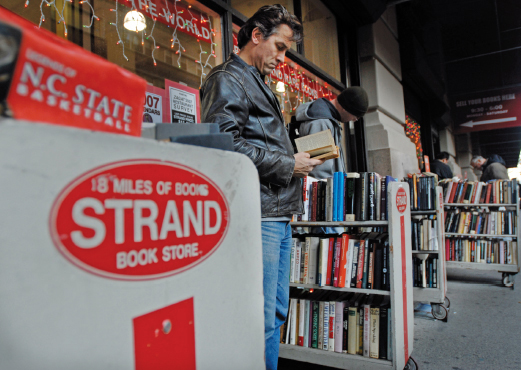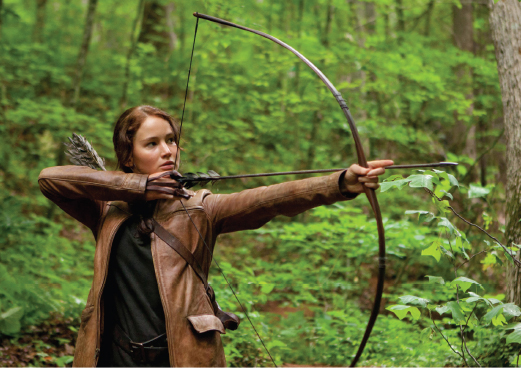Money In
Printed Page 47
Compared with other mass media industries, book publishing has seen only a relatively modest increase in revenues over the decades. From the mid-1980s to 2010, total revenues went from $9 billion to about $27.9 billion. But the industry continues to seek new and bigger sources of growth. Publishers bring in money through a variety of channels.
Book Sales

The most obvious source of revenue for publishers are sales of the books themselves—whether they’re in print, audio, or e-book form. There are several main outlets for selling books:
- Brick-and-mortar stores. These include traditional bookstores, department stores, drugstores, used-book stores, and toy stores. After the 2011 bankruptcy of Borders-Waldenbooks, book sales are now dominated by the single largest chain, Barnes & Noble. Barnes & Noble operates more than 705 superstores, though it closed its remaining smaller B. Dalton bookstores in 2010. The rise of book superstores—along with competition from online stores—severely cut into independent bookstores’ business, dropping their number from 5,100 in 1991 to only about 2,200 today. Many independents have formed regional or statewide groups to develop survival tactics.
- Online stores. Since the late 1990s, online booksellers have created an entirely new book-distribution system on the Internet. The trailblazer is Amazon.com, established in 1995 by then-thirty-year-old Jeff Bezos. In 1997, Barnes & Noble, the leading retail store bookseller, launched its own heavily invested and carefully researched bn.com site. In 1999, the American Booksellers Association also launched BookSense.com to help more than a thousand independent bookstores establish an online presence. The strength of online sellers lies in their convenience and low prices, especially their ability to offer backlist titles and the works of less famous authors that even superstores don’t carry on their shelves. Many online customers also appreciate the ability to post their own book reviews at online stores, read those of fellow customers, and receive book recommendations based on their searches and past purchases. As book readers turn to e-books, online stores are better situated for this transition. By 2011, customers were buying more e-books than print books from Amazon.
- Book clubs. Book clubs, similar to music clubs, entice new members with offers such as five books for a dollar, then require regular purchases from their list of recommended titles. The Book-of-the-Month Club and the Literary Guild are two examples, both launched in 1926. Originally, this business model helped generate revenues when bookstores were not as numerous as they are today. But since the 1980s, book clubs’ sales have declined.
- Mail order. Mail-order bookselling was another tactic introduced before bookstores became a major channel for selling, now used primarily by trade, professional, and university press publishers. A mail-order company, like a book club, immediately notifies readers about new book titles. This channel appeals to customers who want to avoid the hassle of shopping in stores or who want their purchases (for example, of sexually explicit materials) to remain private.

VideoCentral
 bedfordstmartins.com/ mediaessentials
bedfordstmartins.com/ mediaessentials

Based On: Making Books into Movies
Writers and producers discuss the process that brings a book to the big screen.
Discussion: How is the creative process of writing a novel different from making a movie? Which would you rather do, and why?
Regardless of what channel a publisher sells its books through, trade publishers are constantly on the hunt for the next best-seller—inspired by the huge success of Harriet Beecher Stowe’s abolitionist novel Uncle Tom’s Cabin, which sold a then-whopping 15,000 copies in just fifteen days back in 1852. (A total of 3 million copies flew off the shelves before the Civil War.) A best-seller can come from anywhere—a celebrity who pens his or her autobiography, a respected scientist who offers a provocative new perspective on artificial intelligence, a first-time novelist whose work is chosen for Oprah’s Book Club.

Indeed, publishers have learned that TV can help sell books. Through TV ex-posure, books by or about talk-show hosts, actors, and politicians sell millions of copies—enormous sales in a business where 100,000 units sold constitutes remarkable success. In national polls conducted from the 1980s through today, nearly 30 percent of respondents said they had read a book after seeing the story or a promotion on television. A major force in promoting books on TV was Oprah’s Book Club. Each selection by the club—before it made its transition online to Book Club 2.0 in 2012—became an immediate best-seller.
TV and Movie Rights
Many TV shows and films get their story ideas from books, a process that generates enormous movie-rights revenues for the book industry and its authors. The most profitable movie-rights deals for the book industry in recent years have included the Harry Potter films as well as Peter Jackson’s movie adaptations of J. R. R. Tolkien’s Lord of the Rings series (first published in the 1950s). Books and their adaptations create desirable cross-promotion. HBO’s adaptation of A Game of Thrones, the first book in George R. R. Martin’s A Song of Ice and Fire series, pushed Martin’s work to the top of best-seller lists and promoted the publication of the fifth book in the series, A Dance with Dragons. TV or movie promotion can also boost sales in new media: In September 2011, Martin joined Amazon’s “Kindle Million Club,” meaning that e-book sales of his work have exceeded one million downloads. Even classic and public domain books (no longer subject to copyright law) can create profits for the book industry. For example, in 2011, a screen version of Charlotte Brontë’s 1847 novel Jane Eyre boosted sales of the reissued novel.